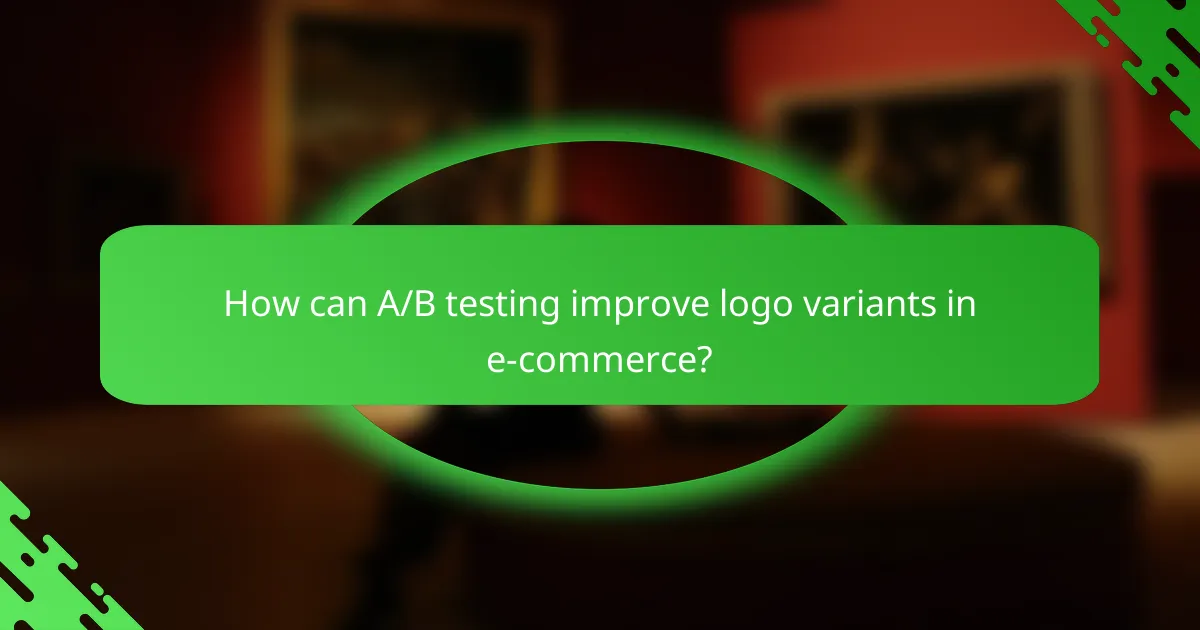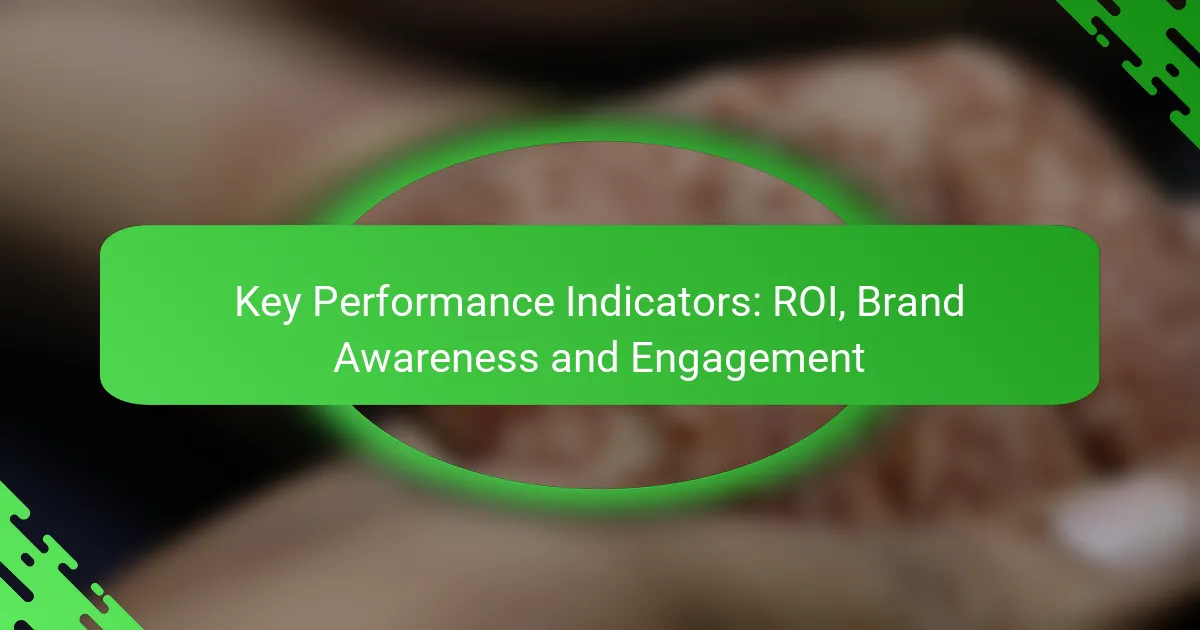A/B testing is a powerful tool for optimizing logo variants in e-commerce, enabling businesses to compare different designs and assess their effects on user engagement and sales. By focusing on performance metrics such as click-through rates and conversion rates, companies can gain valuable insights into user behavior and preferences, ultimately enhancing brand perception and effectiveness.

How can A/B testing improve logo variants in e-commerce?
A/B testing can significantly enhance logo variants in e-commerce by allowing businesses to compare different designs and measure their impact on user engagement and sales. By systematically testing variations, companies can identify which logo resonates best with their audience, leading to improved brand perception and performance.
Enhanced brand recognition
A/B testing helps determine which logo variant fosters better brand recognition among consumers. By presenting different designs to users and tracking their responses, businesses can pinpoint the logo that is more memorable and aligns with their brand identity.
For instance, a logo that incorporates familiar colors or symbols may lead to higher recall rates. Testing can reveal preferences that inform future branding strategies, ensuring that the logo remains consistent across various platforms.
Increased conversion rates
Implementing A/B testing on logo variants can lead to increased conversion rates by identifying designs that encourage users to take action. A logo that appeals to the target demographic can enhance trust and drive purchases.
For example, a logo that conveys professionalism may lead to higher sales in a B2B context, while a playful design might attract a younger audience in a B2C setting. Testing different logos can help optimize the design for maximum impact on conversion.
Data-driven design decisions
Using A/B testing allows e-commerce businesses to make data-driven design decisions regarding their logos. Instead of relying on subjective opinions, companies can analyze user behavior and preferences to inform their branding choices.
This approach minimizes risks associated with launching a new logo, as decisions are backed by empirical evidence. Regular testing can help brands stay relevant and responsive to changing consumer tastes, ensuring ongoing alignment with market trends.

What performance metrics should be tracked in A/B testing?
When conducting A/B testing, it is crucial to track performance metrics that provide insights into user behavior and the effectiveness of different variants. Key metrics include click-through rate (CTR), conversion rate, and engagement metrics, each offering a unique perspective on how users interact with your content.
Click-through rate (CTR)
Click-through rate (CTR) measures the percentage of users who click on a specific link compared to the total number of users who view a page. A higher CTR indicates that your logo variant is more appealing or relevant to users. Aim for a CTR that is significantly above the industry average, which typically ranges from 1% to 5% depending on the sector.
To improve CTR, consider using compelling calls to action and visually engaging designs. Regularly analyze which elements contribute to higher CTRs and adjust your A/B tests accordingly.
Conversion rate
Conversion rate refers to the percentage of users who complete a desired action, such as making a purchase or signing up for a newsletter, after interacting with your logo variant. This metric is critical as it directly correlates with your business goals. A good conversion rate can vary widely, but many businesses aim for rates between 2% and 10%.
To enhance conversion rates, ensure that your logo aligns with your brand message and resonates with your target audience. Testing different placements and designs can help identify what drives users to convert.
Engagement metrics
Engagement metrics encompass various indicators of how users interact with your content, such as time spent on page, bounce rate, and social shares. These metrics provide a broader understanding of user interest and satisfaction. High engagement often correlates with better conversion rates.
Monitor these metrics to identify trends and patterns in user behavior. For instance, if a logo variant leads to longer time spent on the page but lower conversions, it may indicate that users are intrigued but not compelled to act. Adjust your strategy based on these insights to optimize overall performance.

How to analyze user response to logo variants?
To analyze user response to logo variants, gather qualitative and quantitative data that reflects how users interact with different logo designs. This involves using various methods to assess preferences, engagement levels, and overall impact on brand perception.
User feedback surveys
User feedback surveys are a direct way to gauge opinions on logo variants. Create short, focused surveys that ask users to rate their preferences and provide comments on each design. Aim for a sample size that represents your target audience to ensure reliable insights.
Consider using a mix of multiple-choice questions and open-ended responses to capture both quantitative ratings and qualitative feedback. Tools like Google Forms or SurveyMonkey can facilitate this process.
Heatmaps and session recordings
Heatmaps and session recordings provide visual insights into user interactions with logo variants on your website. Heatmaps show where users click, scroll, and hover, revealing which logos attract more attention. Session recordings allow you to see how users navigate your site and respond to different logos in real-time.
Utilize tools like Hotjar or Crazy Egg to collect this data. Analyze patterns to determine which logo variant keeps users engaged longer and leads to desired actions, such as clicks or conversions.
Social media engagement
Social media engagement metrics can indicate how well different logo variants resonate with your audience. Track likes, shares, comments, and overall reach when you post logos on platforms like Facebook, Instagram, or Twitter. A logo that generates higher engagement may be more appealing to your target demographic.
Use social media analytics tools to compare the performance of each logo variant over time. This can help identify trends and preferences that inform your branding decisions. Aim for a consistent posting schedule to gather sufficient data for analysis.

What are the best practices for A/B testing logos?
To effectively A/B test logos, focus on clear objectives, isolate variables, and ensure an adequate sample size. These practices help in accurately measuring user response and determining which logo variant performs better.
Define clear objectives
Establishing clear objectives is crucial for A/B testing logos. Determine what you want to achieve, whether it’s increasing brand recognition, improving click-through rates, or enhancing user engagement. Specific goals guide the testing process and help in evaluating success.
For example, if the objective is to boost website visits, track metrics like click-through rates or time spent on the site after users interact with the logo. This clarity ensures that the testing aligns with broader marketing strategies.
Test one variable at a time
Testing one variable at a time is essential to isolate the effects of each logo variant. If multiple changes are made simultaneously, it becomes challenging to determine which modification influenced user response. Stick to altering only the logo design while keeping other elements constant.
This approach allows for precise analysis. For instance, if you change the color and shape of the logo at once, you won’t know if the color or shape had a greater impact on user behavior. Focus on one aspect to draw clearer conclusions.
Use a sufficient sample size
A sufficient sample size is vital for reliable A/B testing results. A small number of participants can lead to skewed data and unreliable conclusions. Aim for a sample that reflects your target audience, ideally in the hundreds or thousands, depending on your overall traffic.
For example, if your website receives a few thousand visitors daily, consider running the test for at least a week to gather enough data. This timeframe allows for variations in user behavior across different days and times, leading to more accurate insights.

What tools are available for A/B testing logos?
Several tools are available for A/B testing logos, each offering unique features to analyze user responses effectively. These platforms help businesses compare different logo designs and measure their impact on performance metrics like conversion rates and user engagement.
Optimizely
Optimizely is a leading A/B testing tool that allows users to create and test multiple logo variants seamlessly. It offers a user-friendly interface and robust analytics to track how different logos perform across various segments of your audience.
When using Optimizely, consider its integration capabilities with other marketing tools to enhance your testing strategy. The platform supports multivariate testing, which can be particularly useful for assessing multiple design elements simultaneously.
VWO
VWO (Visual Website Optimizer) provides a comprehensive suite for A/B testing, including logo variations. Its visual editor makes it easy to create tests without needing extensive coding knowledge, allowing marketers to focus on design and user experience.
VWO also offers heatmaps and session recordings, which can provide insights into how users interact with different logo designs. This data can help identify which elements resonate best with your target audience.
Google Optimize
Google Optimize is a free tool that integrates well with Google Analytics, making it a great option for businesses looking to test logo variants without significant investment. It allows for straightforward A/B testing and provides valuable insights into user behavior.
While Google Optimize is user-friendly, it may have limitations in advanced features compared to paid tools. However, it is an excellent starting point for small to medium-sized businesses aiming to understand the impact of logo changes on user engagement.

What are common pitfalls in A/B testing logo variants?
Common pitfalls in A/B testing logo variants include failing to account for statistical significance and testing too many variables simultaneously. These mistakes can lead to misleading results and ineffective design decisions.
Ignoring statistical significance
Ignoring statistical significance can result in drawing incorrect conclusions from A/B test results. It’s crucial to ensure that the observed differences in user response to logo variants are not due to random chance. Typically, a p-value of less than 0.05 is considered statistically significant.
To avoid this pitfall, use a sample size calculator to determine the necessary number of participants for your test. A larger sample size generally provides more reliable results, reducing the likelihood of false positives.
Testing too many variables
Testing too many variables at once can complicate the analysis and obscure which changes actually impacted user behavior. When multiple elements are altered, it becomes challenging to pinpoint the cause of any observed differences in performance metrics.
Focus on one or two logo variants at a time to maintain clarity in your results. For instance, if you’re testing color and font simultaneously, you may not know which factor influenced user preference. A good practice is to prioritize changes based on their potential impact and test them sequentially.


